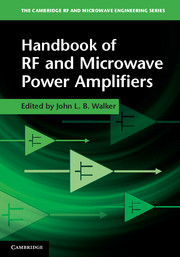Book contents
- Frontmatter
- Contents
- Contributors
- Preface
- 1 Silicon LDMOS and VDMOS transistors
- 2 GaAs FETs – physics, design, and models
- 3 Wide band gap transistors – SiC and GaN – physics, design and models
- 4 Amplifier classes, A to S
- 5 Computer-aided design of power amplifiers
- 6 Practical HF/VHF/UHF RF power amplifier realization
- 7 Microwave hybrid amplifier realization
- 8 Monolithic power amplifiers
- 9 RF power amplifier thermal design
- 10 Reliability
- 11 Power amplifier applications
- 12 Amplifier measurements
- About the authors
- Index
- References
7 - Microwave hybrid amplifier realization
Published online by Cambridge University Press: 05 November 2011
- Frontmatter
- Contents
- Contributors
- Preface
- 1 Silicon LDMOS and VDMOS transistors
- 2 GaAs FETs – physics, design, and models
- 3 Wide band gap transistors – SiC and GaN – physics, design and models
- 4 Amplifier classes, A to S
- 5 Computer-aided design of power amplifiers
- 6 Practical HF/VHF/UHF RF power amplifier realization
- 7 Microwave hybrid amplifier realization
- 8 Monolithic power amplifiers
- 9 RF power amplifier thermal design
- 10 Reliability
- 11 Power amplifier applications
- 12 Amplifier measurements
- About the authors
- Index
- References
Summary
Introduction
The variety of approaches taken in the design of power amplifiers is vast and the subdividing of the approaches into various categories, such as “hybrid” is (like the term microwave itself) a generalization in which the edges are somewhat blurred. The Cambridge Advanced Dictionary defines hybrid as something “that has been produced from two different types…especially to get better characteristics, or anything that is a mixture of two very different things.” In this case the mixture is considered to be of lumped and distributed components. Until recently a hybrid amplifier was considered as one which used packaged devices, however in striving to achieve better performance at higher frequencies discrete devices and MMICs have been integrated into circuits containing both distributed circuits and discrete components, see Figure 7.1. Hybrid amplifiers have thus been created as an effort to “cherry pick” the best technical solutions within an economic framework.
The place of hybrid amplifiers in the market ranges from the prototype and feasibility proving stages of product development, to volume manufacturing, to low-quantity highest performance products. Microwave hybrid power amplifiers (MHPAs) are used in low-volume applications such high-energy physics particle accelerators to volume applications in mobile phone base stations. Solid state powers amplifiers (SSPAs) have become the technology of choice for the mobile communications market and a significant proportion of the satellite communications market. The advent of wide bandgap materials has seen huge improvements in bandwidth performance below 6 GHz, and the next generation of commercial products will see these advances cover X band and beyond.
- Type
- Chapter
- Information
- Handbook of RF and Microwave Power Amplifiers , pp. 284 - 356Publisher: Cambridge University PressPrint publication year: 2011



